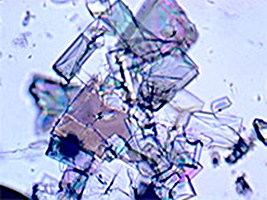
Metal-organic material crystals, viewed in a microscope (Mike Zawortko, University of South Florida)
Researchers at University of South Florida in Tampa and King Abdullah University of Science and Technology in Saudi Arabia (KAUST) developed a new type of metal-organic material with the ability to effectively capture carbon dioxide in the presence of water vapor, which had not been previously possible. The team led by South Florida chemistry professor Michael Zaworotko published its findings online last week in the journal Nature (paid subscription required).
The material has the potential to offer substantial savings to energy companies and others producing quantities of CO2, a greenhouse gas. The authors say the costs to separate CO2 from industrial commodities before it enters the atmosphere currently consumes around 15 percent of global energy production. The demand for these commodities associated with CO2 is projected to triple by 2050.
The researchers engineered the water vapor-resistant properties in a metal-organic material based on hexafluorosilicate, a porous crystal with atoms that form a three-dimensional lattice. The material, with the chemical abbreviation of SIFSIX-1-Cu, is built from combinations of inorganic and organic chemical components. The lattice provides openings that snare molecules of CO2 but allow other molecules in the air to pass.
The search for this type of material began as an undergraduate research project for co-author and now chemistry graduate student Stephen Burd, who works in Zaworotko’s lab. Burd and fellow graduate student Patrick Nugent expanded the study, which eventually involved materials scientists at KAUST. The KAUST collaboration made it possible to design experiments that showed the physical and chemical processes by which the material trapped the CO2.
Confirming the findings required heavy-duty computer simulations using National Science Foundation’s Extreme Science and Engineering Discovery Environment (XSEDE) supercomputer network. The researchers say predicting the exact behavior of molecules requires a huge amount of computer memory. Validation of the team’s findings ended up requiring supercomputer resources in Pittsburgh, Texas, and San Diego on the XSEDE network.
The South Florida/KAUST researchers believe their discovery can be applied to capturing carbon from coal-burning energy plants and the purification of methane in natural gas wells. They cite statistics showing 20 to 30 percent of the power output at a clean-coal plant is consumed by cleaning process, and the their material could make clean-coal plants more efficient and put more power into the grid. They plan to collaborate with engineers to determine manufacturing and implementation processes.
Read more:
- Simple Process Developed to Remove Smokestack CO2 Emissions
- Study Aims for Improved Oil Extraction Methods Using CO2
- NSF Grant Funds Research on CO2 as Fossil Fuel Substitute
- Universities Awarded Clean Coal Research Grants
- University Start-Up to Generate Power with Stored CO2
* * *

 RSS - Posts
RSS - Posts
You must be logged in to post a comment.